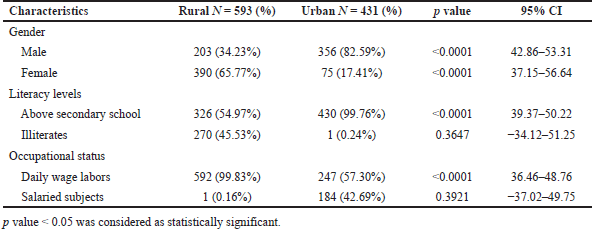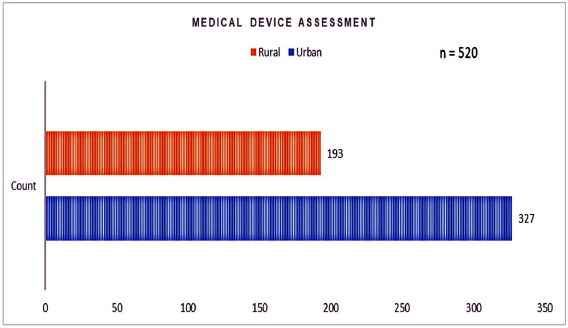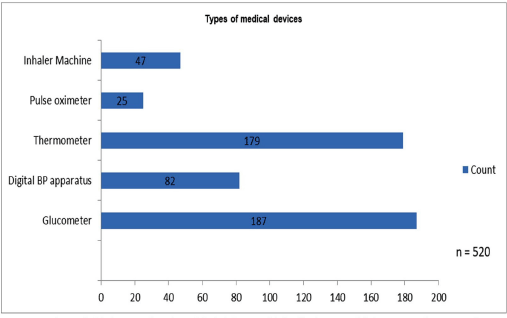INTRODUCTION
Due to rapid industrialization and urbanization, the prevalence of non-communicable diseases (NCDs) like diabetes, hypertension, thyroid, obesity and cardiovascular diseases had increased in the recent past. This is majorly because of the significant modification in the lifestyle. The burden of NCDs was commonly observed among low- and middle-income countries, accounting for an early 80% of all premature mortalities (Arokiasamy, 2018; Baig et al., 2017; Barik and Arokiasamy, 2016; Eren et al., 2008). Furthermore, untreated or uncontrolled diabetes may lead to microvascular and macrovascular complications (Pelluri et al., 2021). In developing countries like India, nearly 62% of the deaths were caused mainly due to the NCDs (Arokiasamy et al., 2018; Eren et al., 2008; Barik et al., 2016; Baig et al., 2017). This state of affairs is due to the improper utilization of primary healthcare settings by 28% and 22% of urban and rural population, respectively (Raban et al., 2012; Ramana et al., 2015; Rathod et al., 2014; Sinha et al., 2017; Pati et al., 2014).
In such a condition, it is essential to utilize the health care resources effectively and regularly should have the monitoring of the various vital signs, like body temperature, blood pressure, heart rate or pulse, and respiratory rate or breathing rate. Along with these parameters, consistent checks of blood sugar levels and body weight changes is also often considered as significant (Pati et al., 2014; Raban et al., 2012; Ramana, 2015; Rathod et al., 2014; Sinha and Pati, 2017). Certain population effected with NCDs, typically use medical devices blood glucose monitors, pulse oximeters, blood pressure monitors, pedometers and weighing scales, and thermometers for constant monitoring of important body metrics in order to diagnose the serious illnesses not only readily but promptly. This had enabled us to improve the effectiveness of treatment and quality of life. In this regard, an assessment study on the use of common medical devices in facilitating the regular observation of the chief body attributes was carried out, all in the comfort of a person’s home (Fleming et al., 2018; Frist, 2014; Garewal, 2015; Nethan et al., 2017). These fundamental health conditions were worse in limited-resource settings, like rural areas, where the true problems of any nation shall be highlighted; however, improving the knowledge regarding the usage of medical devices in these areas also shall help in improving the management of NCDs (Pati et al., 2014; Raban et al., 2012; Ramana, 2015; Rathod et al., 2014; Sinha and Pati, 2017). In view of the above facts, a prospective observational study was conducted in a south Indian district, Kadapa region of Andhra Pradesh, focusing on use of common medical devices used in management of NCDs both in urban and rural settings.
MATERIALS AND METHODS
Study population
The study population included patients of both urban and rural areas of Kadapa district of Andhra Pradesh, India.
Inclusion criteria
Adults of both genders suffering with NCDs and residing in urban and rural areas of Kadapa district were included as study participants.
Exclusion criteria
The following categories of patients were excluded from the study:
a. Vulnerable populations, like pediatrics, geriatrics, and pregnant and lactating women, were excluded.
b. Mentally challenged people were excluded.
c. People who had not given their consent were excluded.
The questionnaire used in the study was according to the World Health Organization WHO STEPwise Approach to NCD Risk Factor Surveillance guidelines. Data were obtained by interviewing each subject, and socio-demographic details, such as age, gender, marital status, occupation, and education, were obtained. Past history and family history of comorbidities, substance abuse, dietary habits, and awareness of any medical emergency number were also included in the questionnaire. This cross-sectional study was conducted on subjects of both genders for a period of 18 months. The medical history of the subjects was collected with the consent of subjects aged ≥35 years and ≤65 years, and this survey was conducted as per the prepared questionnaire and then evaluated. Ethical clearance was obtained before the written (or thumb impression) consent was obtained from each subject and the nature and purpose of the study were explained and they were assured privacy and confidentiality of the information provided. Various medical devices that were included in this study were digital BP apparatus, glucometers, thermometer, inhaler machine, and pulse oximeter.
RESULTS AND DISCUSSION
After the final screening of 3,000 subjects, 1,024 (34.13%) subjects met the criteria; 45.31% and 54.68% were female and male subjects, respectively. In Table 1, it is clearly explained that 26.07% (n = 267) and 73.92% (n = 757) of subjects are illiterates and literates, respectively. Occupational status demonstrated that 17.96% (n = 184) and 82.03% (n = 840) of subjects were salaried and daily wage labors, respectively. The diabetic and hypertensive subjects constituted about 70.70% (n = 724), diabetic subjects constituted 8.7% (n = 90), and other pathological conditions constituted about 20.50% (n = 210). In the south Indian district assessment of healthcare devices, usage was observed among 193 (37.11%) and 327 (68.65%) subjects in rural and urban areas, respectively, and a crystal-clear picture of it is shown in Figure 1. An overview of other NCDs, like heart, cancer, respiratory, kidney, and brain disease, constituted about 7.42% (n = 76), 2.34% (n = 24), 5.56% (n = 57), 3.41% (n = 35), and 1.75% (n = 18), respectively, and all these details are clearly explained in Table 2. Metabolic type of NCDs was more prevalent with a significant p-value < 0.0001, with CI ranging between 25.27 and 35.15. An overview on commonly used healthcare devices is mentioned in Table 3, and the different medical devices used by the subjects were glucometers, digital BP apparatus, thermometer, pulse oximeter, and inhaler machine, constituting about 35.96%, 15.76%, 34.42%, 4.80%, and 9.03%, with significant p-values of 0.1677, 0.0645, 0.0068, 0.6414, and 0.6364, respectively, and all these findings are shown in Figure 2. Knowledge on the usage of various healthcare devices and the medical device usage awareness among the rural masses was found to be 37.11% (n = 193) and urban awareness was found to be 62.88% (n = 327), with a significant p-value < 0.0001, and all these details are clearly explained in Table 4. Eventually, it was clearly understood that awareness on the usage of healthcare devices was slightly more in urban settings compared to rural settings. The digital interventions among the masses with NCDs in India are still in the toddling stage, whereas in developing countries, the situation was a bit better, so some initiatives and programs need to be taken up for igniting the minds of the masses so as to place digital health at dazzling heights (DeGennaro et al., 2018; Joshi et al., 2012; Kandpal et al., 2013; Upadhyay, 2012; Vijayakarthikeyan et al., 2017).
 | Table 1. Demographic details of study participants. [Click here to view] |
 | Figure 1. Medical device assessment was demonstrated among 327 (62.88%) and 193 (37.11%) among urban and rural areas, respectively. [Click here to view] |
 | Table 2. Distribution of NCDs. [Click here to view] |
 | Table 3. Distribution of different devices usage among the population. [Click here to view] |
 | Figure 2. Various medical devices among the study population includes usage of device link glucometers, digital BP apparatus, thermometer, pulse oximeter and inhaler machine constituted about 35.96, 15.76, 34.42, 4.80 and 9.03%, respectively. [Click here to view] |
 | Table 4. Awareness on usage of medical devices among the population. [Click here to view] |
CONCLUSION
From the study’s findings, it is confirmed that knowledge on the usage of medical devices for the management of NCDs was found to be 50.78% in the south Indian district; this very minimal as compared to the other developed countries, so each and every individual should remember that this digital health is the need of the hour in the global village, to be as the survival of the fittest, and led a healthy life with no quality adjusted life years. Some of the limitations of this study include that a diverse variety of devices was not monitored and data collection from geriatric patients was challenging and geographically was confined to one region only. In the future, this study can be extended to other regions as well.
ACKNOWLEDGMENTS
The authors express their deep gratitude to the preceptor, college management, and village heads for allowing fair conduct of the study.
LIST OF ABBREVIATIONS
CI: confidence interval; NCDs: noncommunicable diseases; p-value: probability value.
AUTHOR CONTRIBUTIONS
All authors made substantial contributions to conception and design, acquisition of data, or analysis and interpretation of data; took part in drafting the article or revising it critically for important intellectual content; agreed to submit to the current journal; gave final approval of the version to be published; and agree to be accountable for all aspects of the work. All the authors are eligible to be an author as per the international committee of medical journal editors (ICMJE) requirements/guidelines.
FUNDING
There is no funding to report.
CONFLICTS OF INTEREST
The authors report no financial or any other conflicts of interest in this work.
DATA AVAILABILITY
All data generated and analyzed are included within this research article.
PUBLISHER’S NOTE
This journal remains neutral with regard to jurisdictional claims in published institutional affiliation.
ETHICAL CONSIDERATION
The study procedure was approved by the Institutional Review board, Dated:21.02.2020 (IRB/Jan/75) of Vasavi institute of pharmaceutical sciences. Kadapa. The present study was conducted accordance with good clinical practice guidelines. Informed consent form was collected before enrolling into the study.
REFERENCES
Arokiasamy P. India’s escalating burden of non-communicable diseases. Lancet Glob Health, 2018; 6(12):e1262–3. CrossRef
Barik D, Arokiasamy P. Rising health expenditure due to non-communicable diseases in India: an outlook. Front Public Health, 2016; 4:268. CrossRef
Baig M, GholamHosseini H, Moqeem AA, Mirza F, Lindén M. A systematic review of wearable patient monitoring systems—current challenges and opportunities for clinical adoption. J Med Syst, 2017; 41(7):1–9. CrossRef
DeGennaro Jr V, Malcolm S, Crompton L, Vaddiparti K, Mramba LK, Striley C, Cottler L, Taylor K, Leverence R. Community-based diagnosis of non-communicable diseases and their risk factors in rural and urban Haiti: a cross-sectional prevalence study. Br Med J, 2018; 8:e020317. CrossRef
Eren A, Subasi A, Coskun O. A decision support system for telemedicine through the mobile telecommunications platform. J Med Syst, 2008; 32(1):31–5. CrossRef
Fleming TP, Watkins AJ, Velazquez MA. Origins of lifetime health around the time of conception: causes and consequences. Lancet, 2018; 391:1842–52. CrossRef
Frist WH. Connected health and the rise of the patient-consumer. Health Aff (Millwood), 2014; 33:191–3. CrossRef
Garewal K. HIT, insightful coverage of healthcare technology. 10 Indian digital health startups to watch. HIT, 2015.
Joshi SR, Saboo B, Vadivale M, Dani SI, Mithal A, Kaul U, Badgandi M, Iyengar SS, Viswanathan V, Sivakadaksham N, Chattopadhyaya PS. Prevalence of diagnosed and undiagnosed diabetes and hypertension in India—results from the screening India’s twin epidemic (SITE) study. Diabetes Technol Ther, 2012; 14(1):8–15. CrossRef
Kandpal SD, Kakkar R, Aggarwal P, Bansal S. Pattern of prevalence of risk factors for non-communicable diseases in the geriatric population of district Dehradun. J Indian Acad Clin Med, 2013; 14(3–4):214–7.
Nethan S, Sinha D, Mehrotra R. Non communicable disease risk factors and their trends in India. Asian Pac J Cancer Prev, 2017; 18:2005–10.
Pati S, Agrawal S, Swain S, Lee JT, Vellakkal S, Hussain MA, Millett C. Non communicable disease multimorbidity and associated health care utilization and expenditures in India: cross-sectional study. BMC Health Serv Res, 2014; 14:1–9. CrossRef
Pelluri R, Srikanth K, Chimakurthy J, Nagasubramanian VR. Microvascular complications and their associated risk factors among rural type 2 diabetic population: a cross-sectional study. SN Compr Clin Med, 2021; 3(2):625–31. CrossRef
Raban MZ, Dandona R, Dandona L. Availability of data for monitoring noncommunicable disease risk factors in India. Bull World Health Organ, 2012; 90(1):20–9. CrossRef
Ramana TV. Make in India: is a possible reality project or merely an illusion? Int J Acad Res, 2015; 2:10–20.
Rathod H, Darade S, Chitnis U, Bhawalkar J, Jadhav S, Banerjee A. Rural prevalence of type 2 diabetes mellitus: a cross sectional study. J Soc Health Diabetes, 2014; 02(02):082–6. CrossRef
Sinha R, Pati S. Addressing the escalating burden of chronic diseases in India: need for strengthening primary care. J Family Med Prim Care, 2017; 6(4):701–8. CrossRef
Upadhyay RP. An overview of the burden of non-communicable diseases in India. Iran J Public Health, 2012; 41(3):1–8.
Vijayakarthikeyan M, Krishnakumar J, Umadevi R. Cross-sectional study on the prevalence of risk factors for non-communicable disease in a rural area of Kancheepuram, Tamil Nadu. Int J Community Med Public Health, 2017; 4(12):4600–7. CrossRef
World Health Organization. World Health Organization for STEPwise approach to non-communicable disease risk factor surveillance (STEPS). Available via https://www.who.int/teams/noncommunicable-diseases/surveillance/systems-tools/steps/instrument